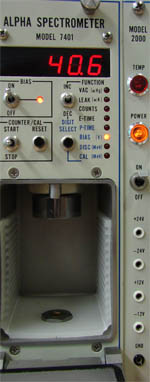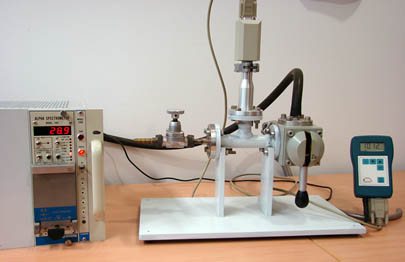Alpha-Particle Spectroscopy with a Semiconductor Detector
Supervisor: M. Sc. D. Plotzki
 The
interaction of alpha-particles with gaseous and solid samples
is investigated with the help of a multi-channel spectrometer.
The alpha-particles are emitted from an americium-241-sample.
The experiment introduces the energy spectroscopy on fast ions
and there application for the determination of material
properties. Helium ions from particle accelerators are used
for instance in the Rutherford back-scattering spectroscopy
(RBS) which is a very handy tool for analysing solid state
thin films and single-crystal samples. The standard freedom of
the RBS is due to the ease in modelling the particle behaviour
in arbitrary surroundings (this is done on simple examples in
the experiment). Besides the safe dealing with radioactive
samples maintaining the radiation protection is taught.
The
interaction of alpha-particles with gaseous and solid samples
is investigated with the help of a multi-channel spectrometer.
The alpha-particles are emitted from an americium-241-sample.
The experiment introduces the energy spectroscopy on fast ions
and there application for the determination of material
properties. Helium ions from particle accelerators are used
for instance in the Rutherford back-scattering spectroscopy
(RBS) which is a very handy tool for analysing solid state
thin films and single-crystal samples. The standard freedom of
the RBS is due to the ease in modelling the particle behaviour
in arbitrary surroundings (this is done on simple examples in
the experiment). Besides the safe dealing with radioactive
samples maintaining the radiation protection is taught.
The following exercises are to be solved:
- Dependence of the experimental FWHM of the alpha-peaks on the detector voltage and the pressure in the sample chamber
- Energy calibration of the spectrometer
- Determination of the energy loss of the alpha-particle in the dead zone of the detector
- Determination of the range of alpha-particles in air
- Energy loss of alpha-particles in thin foils

instructions NEW
description
of this experiment
